Activity Based Costing and Strategic Alignment for Amcor Limited
VerifiedAdded on 2021/05/30
|13
|3565
|71
Report
AI Summary
This report provides a comprehensive analysis of Activity Based Costing (ABC) and its potential application within Amcor Limited, a multinational packaging company. The report begins with an introduction to the ABC model, detailing its features and how it differs from traditional costing methods. It then examines Amcor Limited's mission, objectives, and corporate strategies, specifically focusing on how ABC can be aligned with these elements to enhance cost management and improve decision-making. The analysis includes a discussion on the benefits of implementing ABC, such as identifying unnecessary costs and improving the allocation of overheads. Furthermore, the report offers recommendations for the successful implementation of ABC within Amcor Limited, including the importance of training and setting measurable objectives. Finally, the report briefly considers alternative management tools, providing a balanced perspective on the best approach for improving Amcor's management accounting practices.
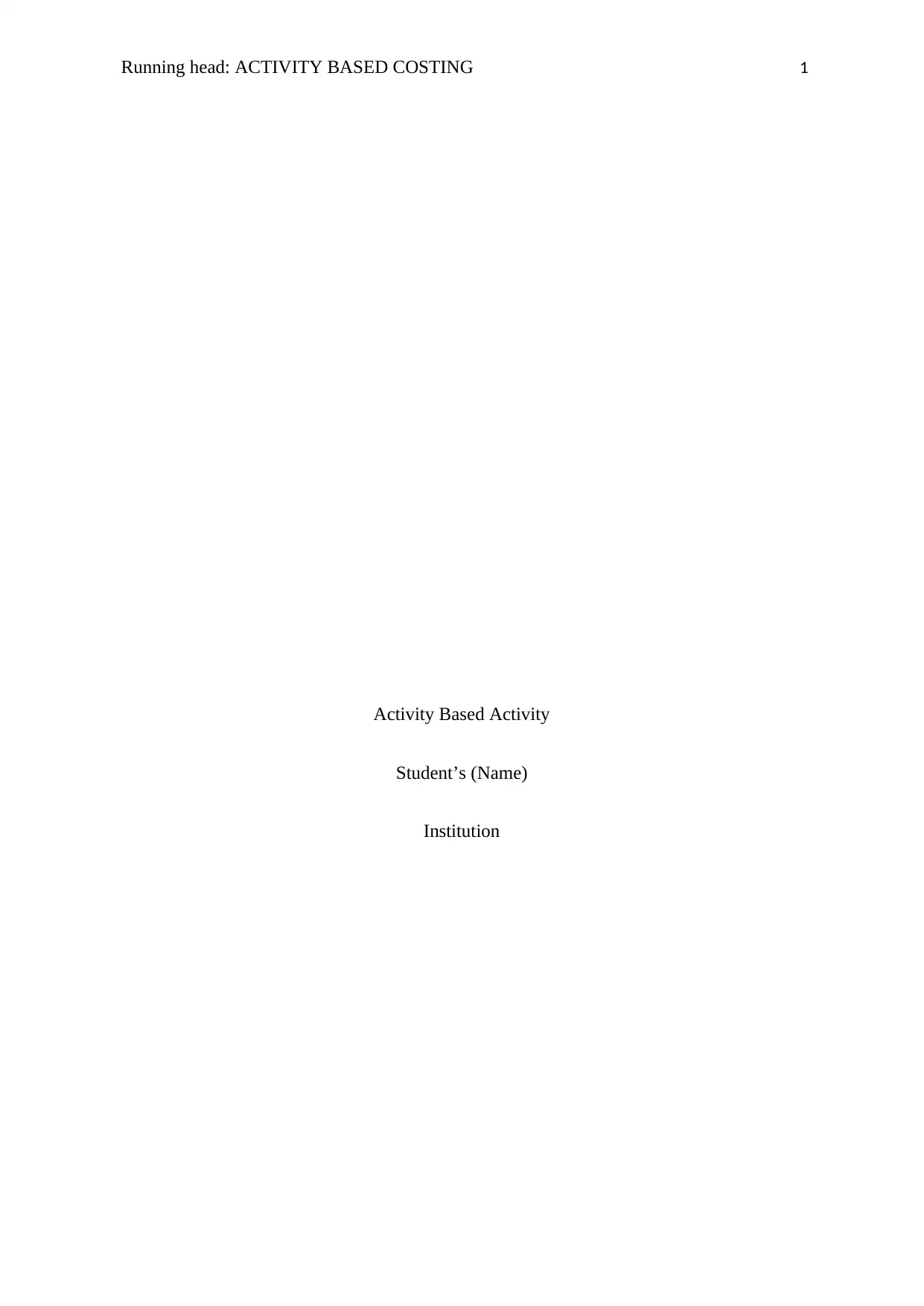
Running head: ACTIVITY BASED COSTING 1
Activity Based Activity
Student’s (Name)
Institution
Activity Based Activity
Student’s (Name)
Institution
Paraphrase This Document
Need a fresh take? Get an instant paraphrase of this document with our AI Paraphraser
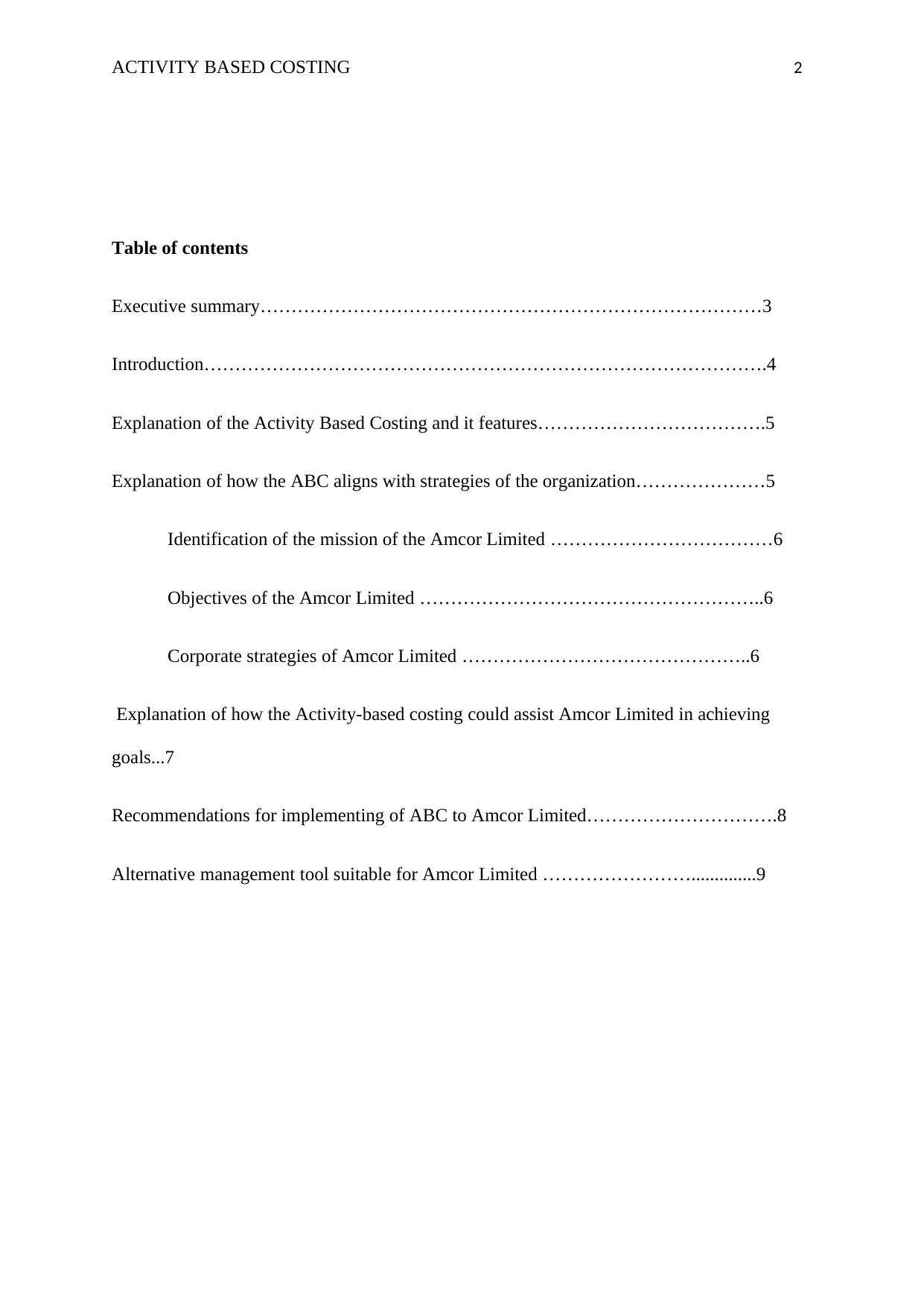
ACTIVITY BASED COSTING 2
Table of contents
Executive summary………………………………………………………………………3
Introduction……………………………………………………………………………….4
Explanation of the Activity Based Costing and it features……………………………….5
Explanation of how the ABC aligns with strategies of the organization…………………5
Identification of the mission of the Amcor Limited ………………………………6
Objectives of the Amcor Limited ………………………………………………..6
Corporate strategies of Amcor Limited ………………………………………..6
Explanation of how the Activity-based costing could assist Amcor Limited in achieving
goals...7
Recommendations for implementing of ABC to Amcor Limited………………………….8
Alternative management tool suitable for Amcor Limited ……………………..............9
Table of contents
Executive summary………………………………………………………………………3
Introduction……………………………………………………………………………….4
Explanation of the Activity Based Costing and it features……………………………….5
Explanation of how the ABC aligns with strategies of the organization…………………5
Identification of the mission of the Amcor Limited ………………………………6
Objectives of the Amcor Limited ………………………………………………..6
Corporate strategies of Amcor Limited ………………………………………..6
Explanation of how the Activity-based costing could assist Amcor Limited in achieving
goals...7
Recommendations for implementing of ABC to Amcor Limited………………………….8
Alternative management tool suitable for Amcor Limited ……………………..............9
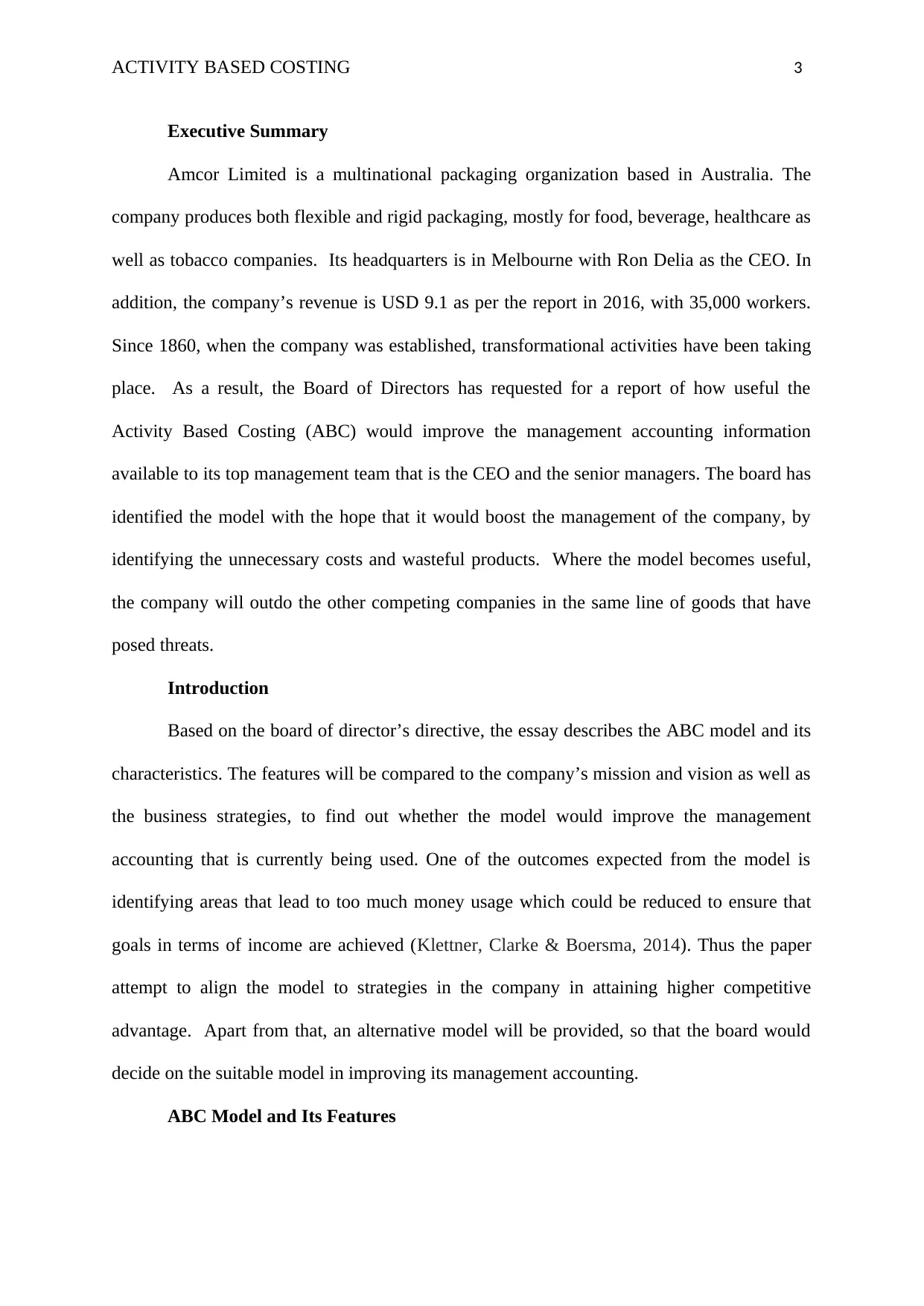
ACTIVITY BASED COSTING 3
Executive Summary
Amcor Limited is a multinational packaging organization based in Australia. The
company produces both flexible and rigid packaging, mostly for food, beverage, healthcare as
well as tobacco companies. Its headquarters is in Melbourne with Ron Delia as the CEO. In
addition, the company’s revenue is USD 9.1 as per the report in 2016, with 35,000 workers.
Since 1860, when the company was established, transformational activities have been taking
place. As a result, the Board of Directors has requested for a report of how useful the
Activity Based Costing (ABC) would improve the management accounting information
available to its top management team that is the CEO and the senior managers. The board has
identified the model with the hope that it would boost the management of the company, by
identifying the unnecessary costs and wasteful products. Where the model becomes useful,
the company will outdo the other competing companies in the same line of goods that have
posed threats.
Introduction
Based on the board of director’s directive, the essay describes the ABC model and its
characteristics. The features will be compared to the company’s mission and vision as well as
the business strategies, to find out whether the model would improve the management
accounting that is currently being used. One of the outcomes expected from the model is
identifying areas that lead to too much money usage which could be reduced to ensure that
goals in terms of income are achieved (Klettner, Clarke & Boersma, 2014). Thus the paper
attempt to align the model to strategies in the company in attaining higher competitive
advantage. Apart from that, an alternative model will be provided, so that the board would
decide on the suitable model in improving its management accounting.
ABC Model and Its Features
Executive Summary
Amcor Limited is a multinational packaging organization based in Australia. The
company produces both flexible and rigid packaging, mostly for food, beverage, healthcare as
well as tobacco companies. Its headquarters is in Melbourne with Ron Delia as the CEO. In
addition, the company’s revenue is USD 9.1 as per the report in 2016, with 35,000 workers.
Since 1860, when the company was established, transformational activities have been taking
place. As a result, the Board of Directors has requested for a report of how useful the
Activity Based Costing (ABC) would improve the management accounting information
available to its top management team that is the CEO and the senior managers. The board has
identified the model with the hope that it would boost the management of the company, by
identifying the unnecessary costs and wasteful products. Where the model becomes useful,
the company will outdo the other competing companies in the same line of goods that have
posed threats.
Introduction
Based on the board of director’s directive, the essay describes the ABC model and its
characteristics. The features will be compared to the company’s mission and vision as well as
the business strategies, to find out whether the model would improve the management
accounting that is currently being used. One of the outcomes expected from the model is
identifying areas that lead to too much money usage which could be reduced to ensure that
goals in terms of income are achieved (Klettner, Clarke & Boersma, 2014). Thus the paper
attempt to align the model to strategies in the company in attaining higher competitive
advantage. Apart from that, an alternative model will be provided, so that the board would
decide on the suitable model in improving its management accounting.
ABC Model and Its Features
⊘ This is a preview!⊘
Do you want full access?
Subscribe today to unlock all pages.

Trusted by 1+ million students worldwide
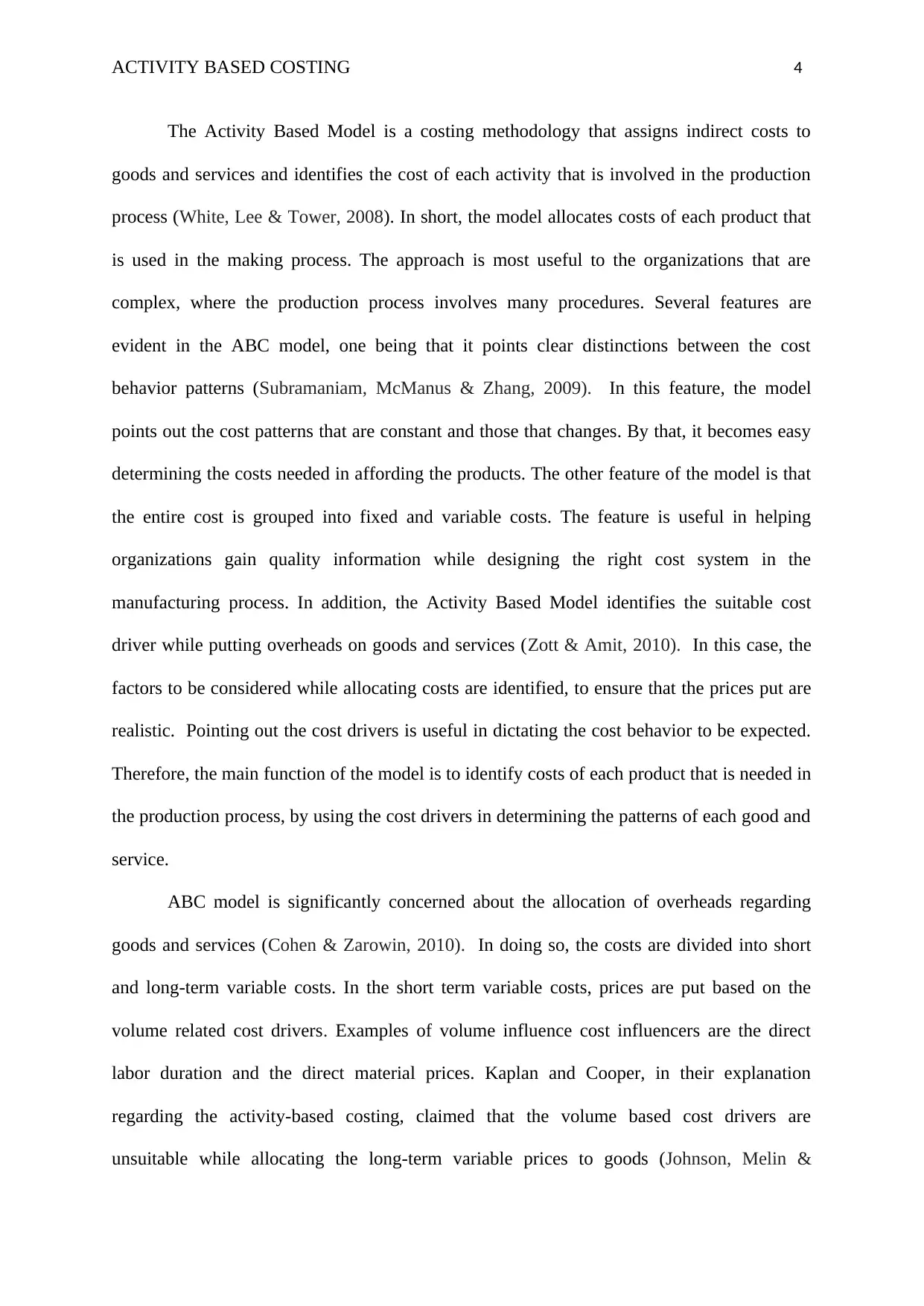
ACTIVITY BASED COSTING 4
The Activity Based Model is a costing methodology that assigns indirect costs to
goods and services and identifies the cost of each activity that is involved in the production
process (White, Lee & Tower, 2008). In short, the model allocates costs of each product that
is used in the making process. The approach is most useful to the organizations that are
complex, where the production process involves many procedures. Several features are
evident in the ABC model, one being that it points clear distinctions between the cost
behavior patterns (Subramaniam, McManus & Zhang, 2009). In this feature, the model
points out the cost patterns that are constant and those that changes. By that, it becomes easy
determining the costs needed in affording the products. The other feature of the model is that
the entire cost is grouped into fixed and variable costs. The feature is useful in helping
organizations gain quality information while designing the right cost system in the
manufacturing process. In addition, the Activity Based Model identifies the suitable cost
driver while putting overheads on goods and services (Zott & Amit, 2010). In this case, the
factors to be considered while allocating costs are identified, to ensure that the prices put are
realistic. Pointing out the cost drivers is useful in dictating the cost behavior to be expected.
Therefore, the main function of the model is to identify costs of each product that is needed in
the production process, by using the cost drivers in determining the patterns of each good and
service.
ABC model is significantly concerned about the allocation of overheads regarding
goods and services (Cohen & Zarowin, 2010). In doing so, the costs are divided into short
and long-term variable costs. In the short term variable costs, prices are put based on the
volume related cost drivers. Examples of volume influence cost influencers are the direct
labor duration and the direct material prices. Kaplan and Cooper, in their explanation
regarding the activity-based costing, claimed that the volume based cost drivers are
unsuitable while allocating the long-term variable prices to goods (Johnson, Melin &
The Activity Based Model is a costing methodology that assigns indirect costs to
goods and services and identifies the cost of each activity that is involved in the production
process (White, Lee & Tower, 2008). In short, the model allocates costs of each product that
is used in the making process. The approach is most useful to the organizations that are
complex, where the production process involves many procedures. Several features are
evident in the ABC model, one being that it points clear distinctions between the cost
behavior patterns (Subramaniam, McManus & Zhang, 2009). In this feature, the model
points out the cost patterns that are constant and those that changes. By that, it becomes easy
determining the costs needed in affording the products. The other feature of the model is that
the entire cost is grouped into fixed and variable costs. The feature is useful in helping
organizations gain quality information while designing the right cost system in the
manufacturing process. In addition, the Activity Based Model identifies the suitable cost
driver while putting overheads on goods and services (Zott & Amit, 2010). In this case, the
factors to be considered while allocating costs are identified, to ensure that the prices put are
realistic. Pointing out the cost drivers is useful in dictating the cost behavior to be expected.
Therefore, the main function of the model is to identify costs of each product that is needed in
the production process, by using the cost drivers in determining the patterns of each good and
service.
ABC model is significantly concerned about the allocation of overheads regarding
goods and services (Cohen & Zarowin, 2010). In doing so, the costs are divided into short
and long-term variable costs. In the short term variable costs, prices are put based on the
volume related cost drivers. Examples of volume influence cost influencers are the direct
labor duration and the direct material prices. Kaplan and Cooper, in their explanation
regarding the activity-based costing, claimed that the volume based cost drivers are
unsuitable while allocating the long-term variable prices to goods (Johnson, Melin &
Paraphrase This Document
Need a fresh take? Get an instant paraphrase of this document with our AI Paraphraser
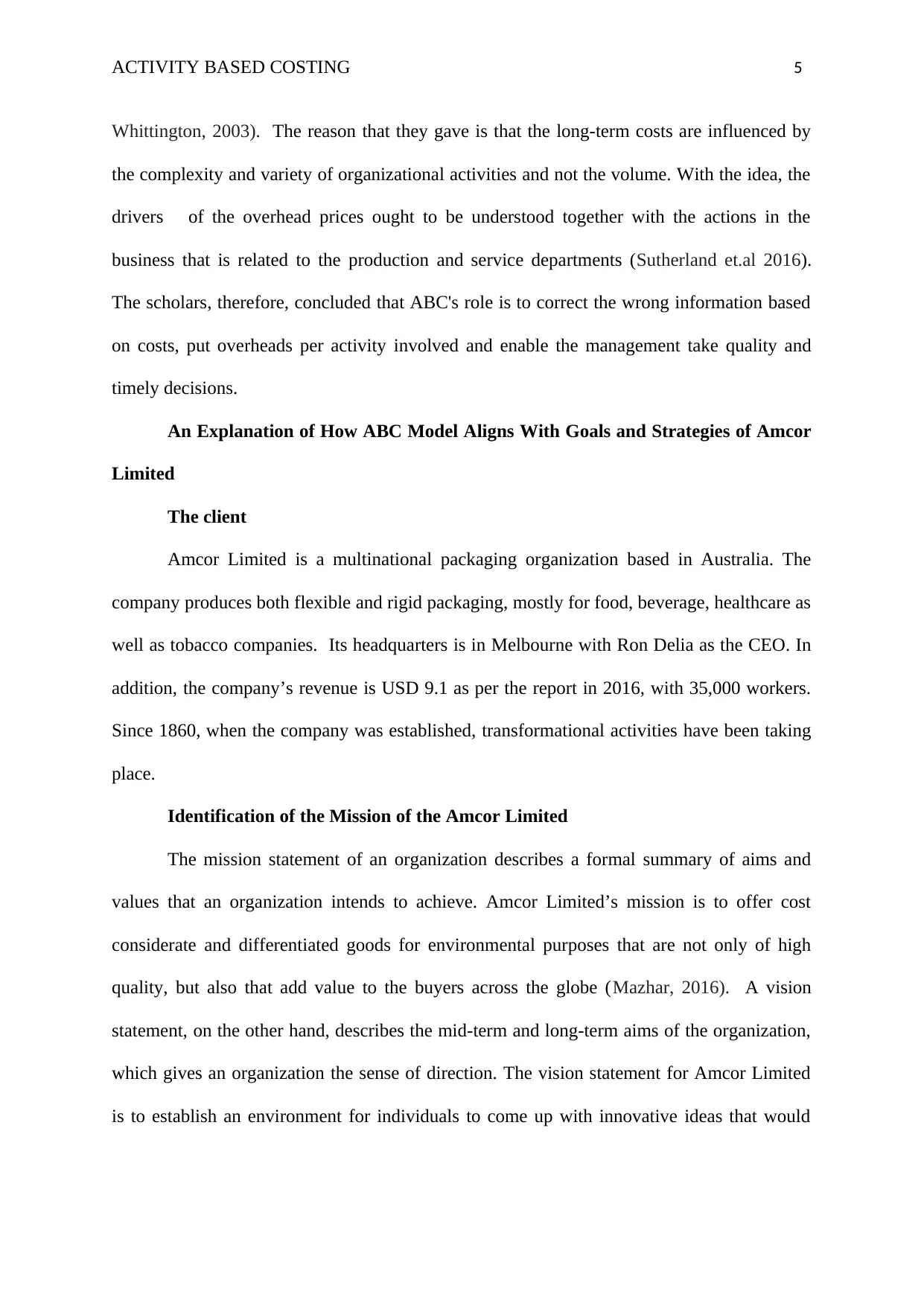
ACTIVITY BASED COSTING 5
Whittington, 2003). The reason that they gave is that the long-term costs are influenced by
the complexity and variety of organizational activities and not the volume. With the idea, the
drivers of the overhead prices ought to be understood together with the actions in the
business that is related to the production and service departments (Sutherland et.al 2016).
The scholars, therefore, concluded that ABC's role is to correct the wrong information based
on costs, put overheads per activity involved and enable the management take quality and
timely decisions.
An Explanation of How ABC Model Aligns With Goals and Strategies of Amcor
Limited
The client
Amcor Limited is a multinational packaging organization based in Australia. The
company produces both flexible and rigid packaging, mostly for food, beverage, healthcare as
well as tobacco companies. Its headquarters is in Melbourne with Ron Delia as the CEO. In
addition, the company’s revenue is USD 9.1 as per the report in 2016, with 35,000 workers.
Since 1860, when the company was established, transformational activities have been taking
place.
Identification of the Mission of the Amcor Limited
The mission statement of an organization describes a formal summary of aims and
values that an organization intends to achieve. Amcor Limited’s mission is to offer cost
considerate and differentiated goods for environmental purposes that are not only of high
quality, but also that add value to the buyers across the globe (Mazhar, 2016). A vision
statement, on the other hand, describes the mid-term and long-term aims of the organization,
which gives an organization the sense of direction. The vision statement for Amcor Limited
is to establish an environment for individuals to come up with innovative ideas that would
Whittington, 2003). The reason that they gave is that the long-term costs are influenced by
the complexity and variety of organizational activities and not the volume. With the idea, the
drivers of the overhead prices ought to be understood together with the actions in the
business that is related to the production and service departments (Sutherland et.al 2016).
The scholars, therefore, concluded that ABC's role is to correct the wrong information based
on costs, put overheads per activity involved and enable the management take quality and
timely decisions.
An Explanation of How ABC Model Aligns With Goals and Strategies of Amcor
Limited
The client
Amcor Limited is a multinational packaging organization based in Australia. The
company produces both flexible and rigid packaging, mostly for food, beverage, healthcare as
well as tobacco companies. Its headquarters is in Melbourne with Ron Delia as the CEO. In
addition, the company’s revenue is USD 9.1 as per the report in 2016, with 35,000 workers.
Since 1860, when the company was established, transformational activities have been taking
place.
Identification of the Mission of the Amcor Limited
The mission statement of an organization describes a formal summary of aims and
values that an organization intends to achieve. Amcor Limited’s mission is to offer cost
considerate and differentiated goods for environmental purposes that are not only of high
quality, but also that add value to the buyers across the globe (Mazhar, 2016). A vision
statement, on the other hand, describes the mid-term and long-term aims of the organization,
which gives an organization the sense of direction. The vision statement for Amcor Limited
is to establish an environment for individuals to come up with innovative ideas that would
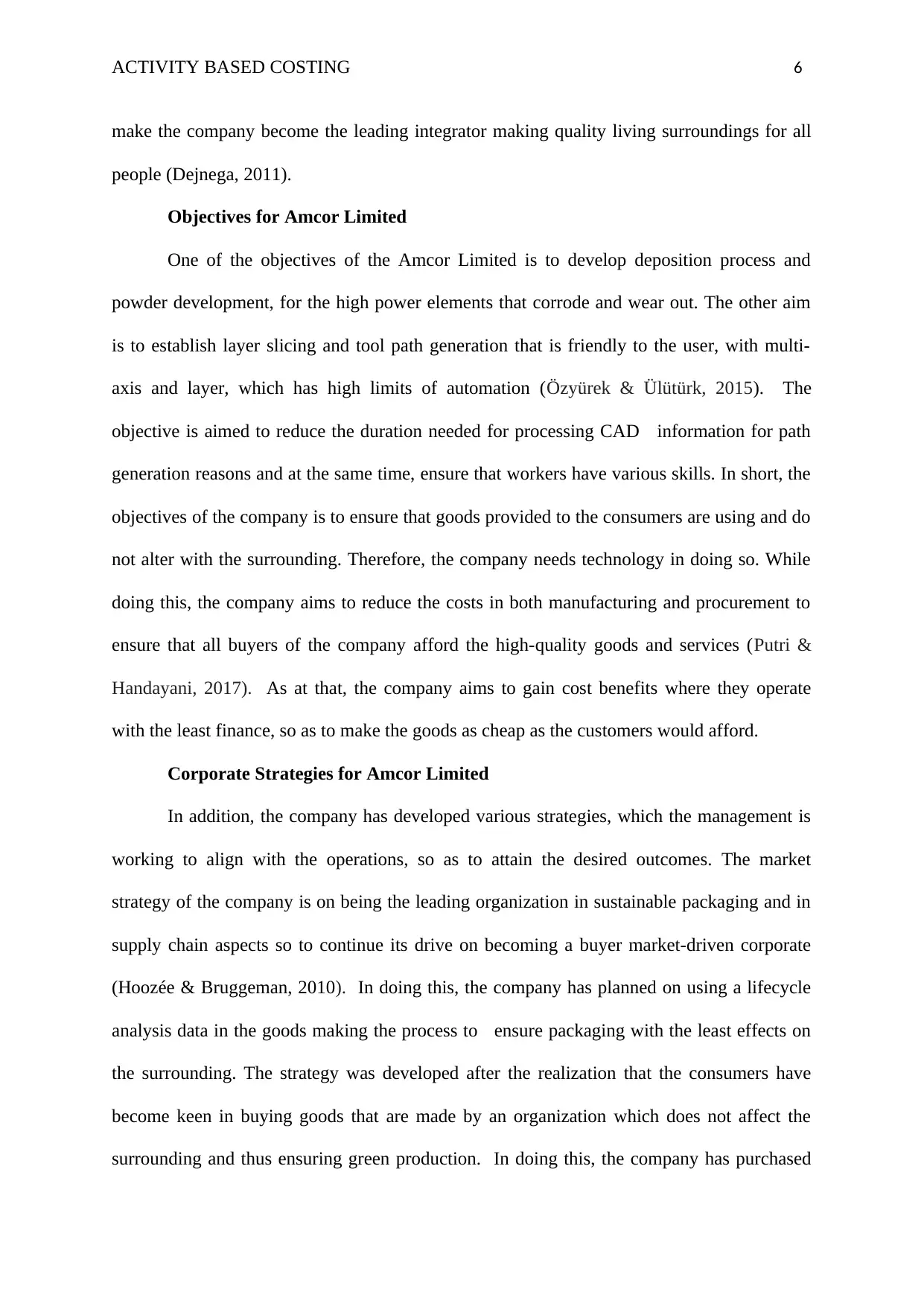
ACTIVITY BASED COSTING 6
make the company become the leading integrator making quality living surroundings for all
people (Dejnega, 2011).
Objectives for Amcor Limited
One of the objectives of the Amcor Limited is to develop deposition process and
powder development, for the high power elements that corrode and wear out. The other aim
is to establish layer slicing and tool path generation that is friendly to the user, with multi-
axis and layer, which has high limits of automation (Özyürek & Ülütürk, 2015). The
objective is aimed to reduce the duration needed for processing CAD information for path
generation reasons and at the same time, ensure that workers have various skills. In short, the
objectives of the company is to ensure that goods provided to the consumers are using and do
not alter with the surrounding. Therefore, the company needs technology in doing so. While
doing this, the company aims to reduce the costs in both manufacturing and procurement to
ensure that all buyers of the company afford the high-quality goods and services (Putri &
Handayani, 2017). As at that, the company aims to gain cost benefits where they operate
with the least finance, so as to make the goods as cheap as the customers would afford.
Corporate Strategies for Amcor Limited
In addition, the company has developed various strategies, which the management is
working to align with the operations, so as to attain the desired outcomes. The market
strategy of the company is on being the leading organization in sustainable packaging and in
supply chain aspects so to continue its drive on becoming a buyer market-driven corporate
(Hoozée & Bruggeman, 2010). In doing this, the company has planned on using a lifecycle
analysis data in the goods making the process to ensure packaging with the least effects on
the surrounding. The strategy was developed after the realization that the consumers have
become keen in buying goods that are made by an organization which does not affect the
surrounding and thus ensuring green production. In doing this, the company has purchased
make the company become the leading integrator making quality living surroundings for all
people (Dejnega, 2011).
Objectives for Amcor Limited
One of the objectives of the Amcor Limited is to develop deposition process and
powder development, for the high power elements that corrode and wear out. The other aim
is to establish layer slicing and tool path generation that is friendly to the user, with multi-
axis and layer, which has high limits of automation (Özyürek & Ülütürk, 2015). The
objective is aimed to reduce the duration needed for processing CAD information for path
generation reasons and at the same time, ensure that workers have various skills. In short, the
objectives of the company is to ensure that goods provided to the consumers are using and do
not alter with the surrounding. Therefore, the company needs technology in doing so. While
doing this, the company aims to reduce the costs in both manufacturing and procurement to
ensure that all buyers of the company afford the high-quality goods and services (Putri &
Handayani, 2017). As at that, the company aims to gain cost benefits where they operate
with the least finance, so as to make the goods as cheap as the customers would afford.
Corporate Strategies for Amcor Limited
In addition, the company has developed various strategies, which the management is
working to align with the operations, so as to attain the desired outcomes. The market
strategy of the company is on being the leading organization in sustainable packaging and in
supply chain aspects so to continue its drive on becoming a buyer market-driven corporate
(Hoozée & Bruggeman, 2010). In doing this, the company has planned on using a lifecycle
analysis data in the goods making the process to ensure packaging with the least effects on
the surrounding. The strategy was developed after the realization that the consumers have
become keen in buying goods that are made by an organization which does not affect the
surrounding and thus ensuring green production. In doing this, the company has purchased
⊘ This is a preview!⊘
Do you want full access?
Subscribe today to unlock all pages.

Trusted by 1+ million students worldwide
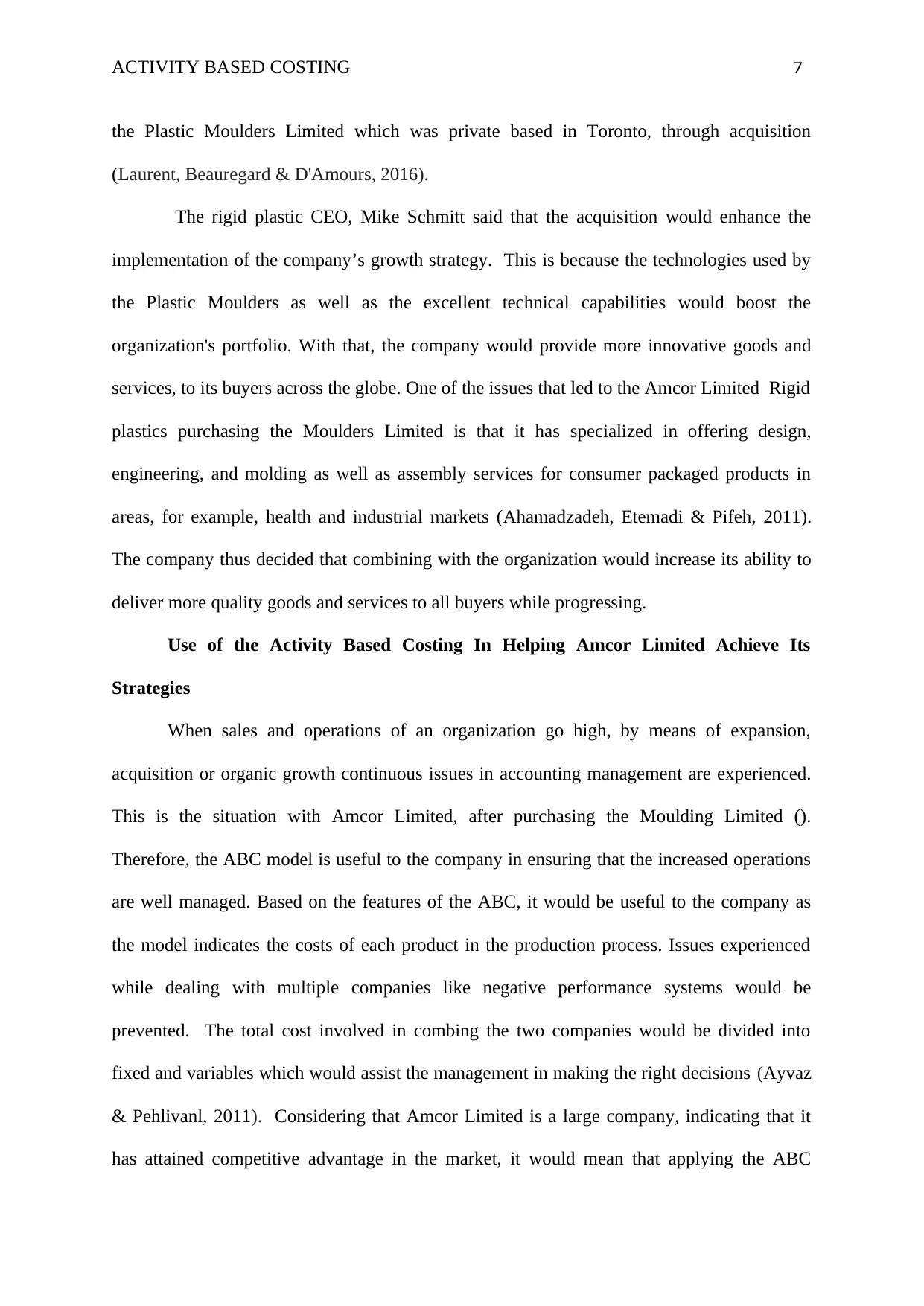
ACTIVITY BASED COSTING 7
the Plastic Moulders Limited which was private based in Toronto, through acquisition
(Laurent, Beauregard & D'Amours, 2016).
The rigid plastic CEO, Mike Schmitt said that the acquisition would enhance the
implementation of the company’s growth strategy. This is because the technologies used by
the Plastic Moulders as well as the excellent technical capabilities would boost the
organization's portfolio. With that, the company would provide more innovative goods and
services, to its buyers across the globe. One of the issues that led to the Amcor Limited Rigid
plastics purchasing the Moulders Limited is that it has specialized in offering design,
engineering, and molding as well as assembly services for consumer packaged products in
areas, for example, health and industrial markets (Ahamadzadeh, Etemadi & Pifeh, 2011).
The company thus decided that combining with the organization would increase its ability to
deliver more quality goods and services to all buyers while progressing.
Use of the Activity Based Costing In Helping Amcor Limited Achieve Its
Strategies
When sales and operations of an organization go high, by means of expansion,
acquisition or organic growth continuous issues in accounting management are experienced.
This is the situation with Amcor Limited, after purchasing the Moulding Limited ().
Therefore, the ABC model is useful to the company in ensuring that the increased operations
are well managed. Based on the features of the ABC, it would be useful to the company as
the model indicates the costs of each product in the production process. Issues experienced
while dealing with multiple companies like negative performance systems would be
prevented. The total cost involved in combing the two companies would be divided into
fixed and variables which would assist the management in making the right decisions (Ayvaz
& Pehlivanl, 2011). Considering that Amcor Limited is a large company, indicating that it
has attained competitive advantage in the market, it would mean that applying the ABC
the Plastic Moulders Limited which was private based in Toronto, through acquisition
(Laurent, Beauregard & D'Amours, 2016).
The rigid plastic CEO, Mike Schmitt said that the acquisition would enhance the
implementation of the company’s growth strategy. This is because the technologies used by
the Plastic Moulders as well as the excellent technical capabilities would boost the
organization's portfolio. With that, the company would provide more innovative goods and
services, to its buyers across the globe. One of the issues that led to the Amcor Limited Rigid
plastics purchasing the Moulders Limited is that it has specialized in offering design,
engineering, and molding as well as assembly services for consumer packaged products in
areas, for example, health and industrial markets (Ahamadzadeh, Etemadi & Pifeh, 2011).
The company thus decided that combining with the organization would increase its ability to
deliver more quality goods and services to all buyers while progressing.
Use of the Activity Based Costing In Helping Amcor Limited Achieve Its
Strategies
When sales and operations of an organization go high, by means of expansion,
acquisition or organic growth continuous issues in accounting management are experienced.
This is the situation with Amcor Limited, after purchasing the Moulding Limited ().
Therefore, the ABC model is useful to the company in ensuring that the increased operations
are well managed. Based on the features of the ABC, it would be useful to the company as
the model indicates the costs of each product in the production process. Issues experienced
while dealing with multiple companies like negative performance systems would be
prevented. The total cost involved in combing the two companies would be divided into
fixed and variables which would assist the management in making the right decisions (Ayvaz
& Pehlivanl, 2011). Considering that Amcor Limited is a large company, indicating that it
has attained competitive advantage in the market, it would mean that applying the ABC
Paraphrase This Document
Need a fresh take? Get an instant paraphrase of this document with our AI Paraphraser
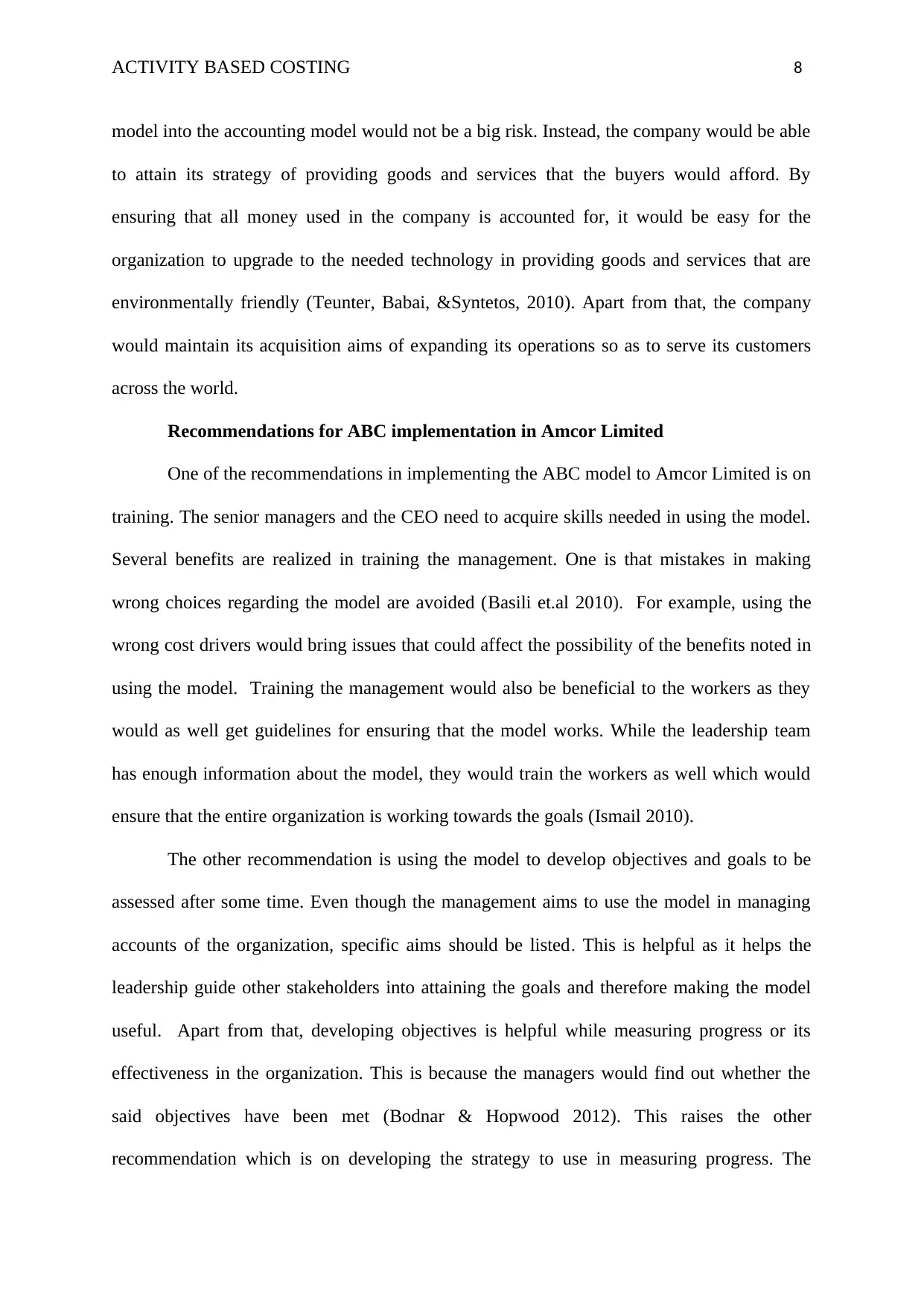
ACTIVITY BASED COSTING 8
model into the accounting model would not be a big risk. Instead, the company would be able
to attain its strategy of providing goods and services that the buyers would afford. By
ensuring that all money used in the company is accounted for, it would be easy for the
organization to upgrade to the needed technology in providing goods and services that are
environmentally friendly (Teunter, Babai, &Syntetos, 2010). Apart from that, the company
would maintain its acquisition aims of expanding its operations so as to serve its customers
across the world.
Recommendations for ABC implementation in Amcor Limited
One of the recommendations in implementing the ABC model to Amcor Limited is on
training. The senior managers and the CEO need to acquire skills needed in using the model.
Several benefits are realized in training the management. One is that mistakes in making
wrong choices regarding the model are avoided (Basili et.al 2010). For example, using the
wrong cost drivers would bring issues that could affect the possibility of the benefits noted in
using the model. Training the management would also be beneficial to the workers as they
would as well get guidelines for ensuring that the model works. While the leadership team
has enough information about the model, they would train the workers as well which would
ensure that the entire organization is working towards the goals (Ismail 2010).
The other recommendation is using the model to develop objectives and goals to be
assessed after some time. Even though the management aims to use the model in managing
accounts of the organization, specific aims should be listed. This is helpful as it helps the
leadership guide other stakeholders into attaining the goals and therefore making the model
useful. Apart from that, developing objectives is helpful while measuring progress or its
effectiveness in the organization. This is because the managers would find out whether the
said objectives have been met (Bodnar & Hopwood 2012). This raises the other
recommendation which is on developing the strategy to use in measuring progress. The
model into the accounting model would not be a big risk. Instead, the company would be able
to attain its strategy of providing goods and services that the buyers would afford. By
ensuring that all money used in the company is accounted for, it would be easy for the
organization to upgrade to the needed technology in providing goods and services that are
environmentally friendly (Teunter, Babai, &Syntetos, 2010). Apart from that, the company
would maintain its acquisition aims of expanding its operations so as to serve its customers
across the world.
Recommendations for ABC implementation in Amcor Limited
One of the recommendations in implementing the ABC model to Amcor Limited is on
training. The senior managers and the CEO need to acquire skills needed in using the model.
Several benefits are realized in training the management. One is that mistakes in making
wrong choices regarding the model are avoided (Basili et.al 2010). For example, using the
wrong cost drivers would bring issues that could affect the possibility of the benefits noted in
using the model. Training the management would also be beneficial to the workers as they
would as well get guidelines for ensuring that the model works. While the leadership team
has enough information about the model, they would train the workers as well which would
ensure that the entire organization is working towards the goals (Ismail 2010).
The other recommendation is using the model to develop objectives and goals to be
assessed after some time. Even though the management aims to use the model in managing
accounts of the organization, specific aims should be listed. This is helpful as it helps the
leadership guide other stakeholders into attaining the goals and therefore making the model
useful. Apart from that, developing objectives is helpful while measuring progress or its
effectiveness in the organization. This is because the managers would find out whether the
said objectives have been met (Bodnar & Hopwood 2012). This raises the other
recommendation which is on developing the strategy to use in measuring progress. The
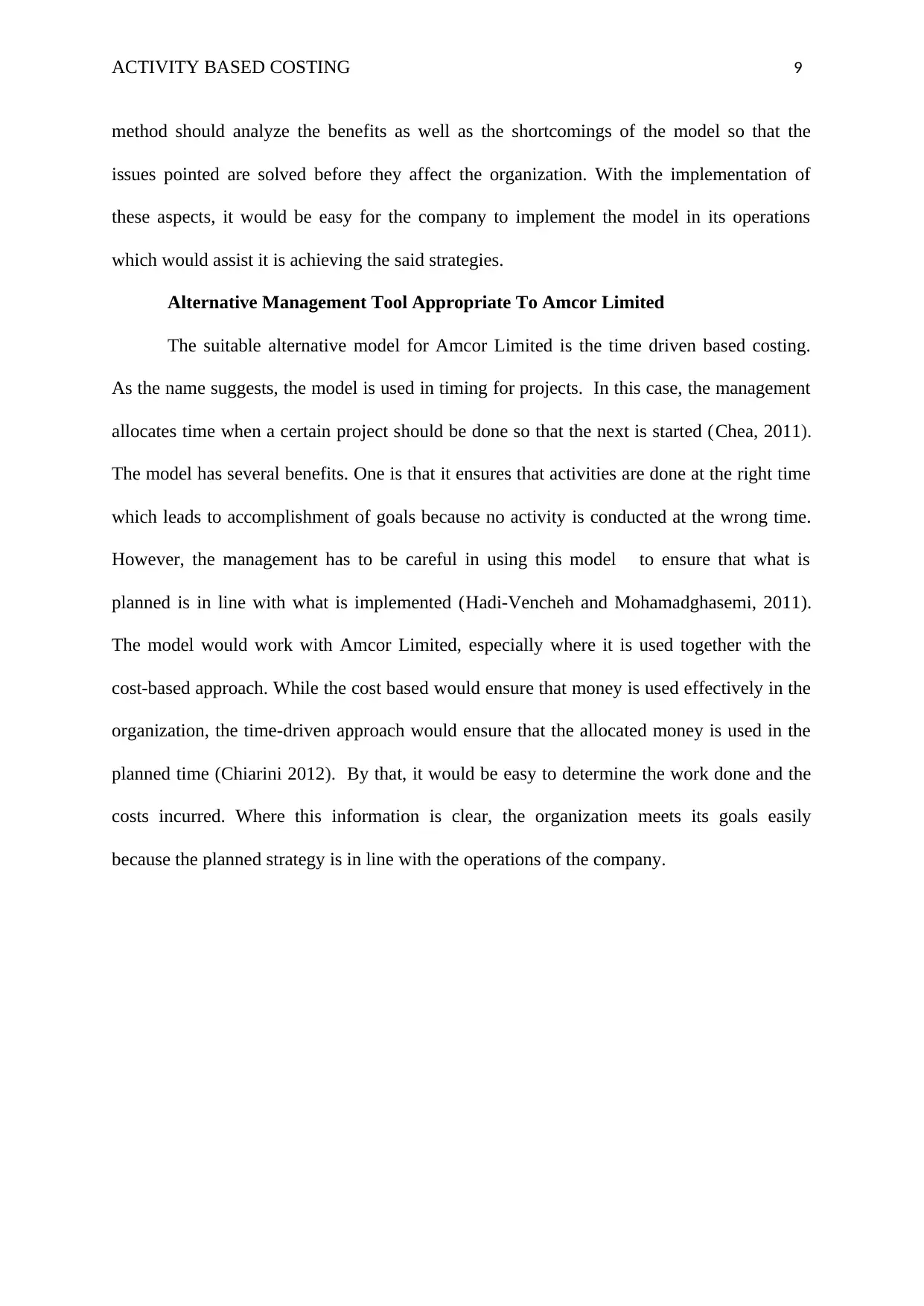
ACTIVITY BASED COSTING 9
method should analyze the benefits as well as the shortcomings of the model so that the
issues pointed are solved before they affect the organization. With the implementation of
these aspects, it would be easy for the company to implement the model in its operations
which would assist it is achieving the said strategies.
Alternative Management Tool Appropriate To Amcor Limited
The suitable alternative model for Amcor Limited is the time driven based costing.
As the name suggests, the model is used in timing for projects. In this case, the management
allocates time when a certain project should be done so that the next is started (Chea, 2011).
The model has several benefits. One is that it ensures that activities are done at the right time
which leads to accomplishment of goals because no activity is conducted at the wrong time.
However, the management has to be careful in using this model to ensure that what is
planned is in line with what is implemented (Hadi-Vencheh and Mohamadghasemi, 2011).
The model would work with Amcor Limited, especially where it is used together with the
cost-based approach. While the cost based would ensure that money is used effectively in the
organization, the time-driven approach would ensure that the allocated money is used in the
planned time (Chiarini 2012). By that, it would be easy to determine the work done and the
costs incurred. Where this information is clear, the organization meets its goals easily
because the planned strategy is in line with the operations of the company.
method should analyze the benefits as well as the shortcomings of the model so that the
issues pointed are solved before they affect the organization. With the implementation of
these aspects, it would be easy for the company to implement the model in its operations
which would assist it is achieving the said strategies.
Alternative Management Tool Appropriate To Amcor Limited
The suitable alternative model for Amcor Limited is the time driven based costing.
As the name suggests, the model is used in timing for projects. In this case, the management
allocates time when a certain project should be done so that the next is started (Chea, 2011).
The model has several benefits. One is that it ensures that activities are done at the right time
which leads to accomplishment of goals because no activity is conducted at the wrong time.
However, the management has to be careful in using this model to ensure that what is
planned is in line with what is implemented (Hadi-Vencheh and Mohamadghasemi, 2011).
The model would work with Amcor Limited, especially where it is used together with the
cost-based approach. While the cost based would ensure that money is used effectively in the
organization, the time-driven approach would ensure that the allocated money is used in the
planned time (Chiarini 2012). By that, it would be easy to determine the work done and the
costs incurred. Where this information is clear, the organization meets its goals easily
because the planned strategy is in line with the operations of the company.
⊘ This is a preview!⊘
Do you want full access?
Subscribe today to unlock all pages.

Trusted by 1+ million students worldwide
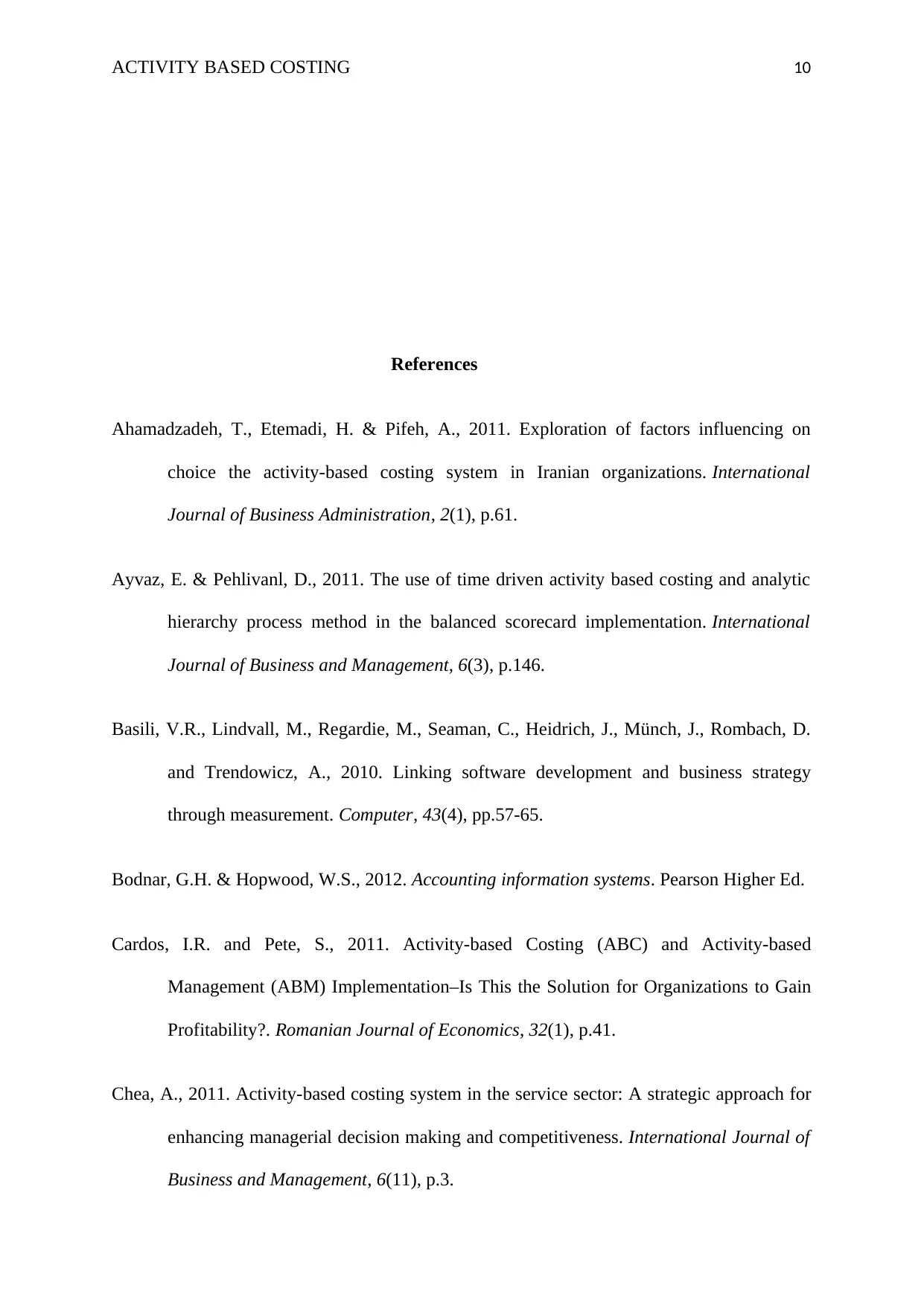
ACTIVITY BASED COSTING 10
References
Ahamadzadeh, T., Etemadi, H. & Pifeh, A., 2011. Exploration of factors influencing on
choice the activity-based costing system in Iranian organizations. International
Journal of Business Administration, 2(1), p.61.
Ayvaz, E. & Pehlivanl, D., 2011. The use of time driven activity based costing and analytic
hierarchy process method in the balanced scorecard implementation. International
Journal of Business and Management, 6(3), p.146.
Basili, V.R., Lindvall, M., Regardie, M., Seaman, C., Heidrich, J., Münch, J., Rombach, D.
and Trendowicz, A., 2010. Linking software development and business strategy
through measurement. Computer, 43(4), pp.57-65.
Bodnar, G.H. & Hopwood, W.S., 2012. Accounting information systems. Pearson Higher Ed.
Cardos, I.R. and Pete, S., 2011. Activity-based Costing (ABC) and Activity-based
Management (ABM) Implementation–Is This the Solution for Organizations to Gain
Profitability?. Romanian Journal of Economics, 32(1), p.41.
Chea, A., 2011. Activity-based costing system in the service sector: A strategic approach for
enhancing managerial decision making and competitiveness. International Journal of
Business and Management, 6(11), p.3.
References
Ahamadzadeh, T., Etemadi, H. & Pifeh, A., 2011. Exploration of factors influencing on
choice the activity-based costing system in Iranian organizations. International
Journal of Business Administration, 2(1), p.61.
Ayvaz, E. & Pehlivanl, D., 2011. The use of time driven activity based costing and analytic
hierarchy process method in the balanced scorecard implementation. International
Journal of Business and Management, 6(3), p.146.
Basili, V.R., Lindvall, M., Regardie, M., Seaman, C., Heidrich, J., Münch, J., Rombach, D.
and Trendowicz, A., 2010. Linking software development and business strategy
through measurement. Computer, 43(4), pp.57-65.
Bodnar, G.H. & Hopwood, W.S., 2012. Accounting information systems. Pearson Higher Ed.
Cardos, I.R. and Pete, S., 2011. Activity-based Costing (ABC) and Activity-based
Management (ABM) Implementation–Is This the Solution for Organizations to Gain
Profitability?. Romanian Journal of Economics, 32(1), p.41.
Chea, A., 2011. Activity-based costing system in the service sector: A strategic approach for
enhancing managerial decision making and competitiveness. International Journal of
Business and Management, 6(11), p.3.
Paraphrase This Document
Need a fresh take? Get an instant paraphrase of this document with our AI Paraphraser
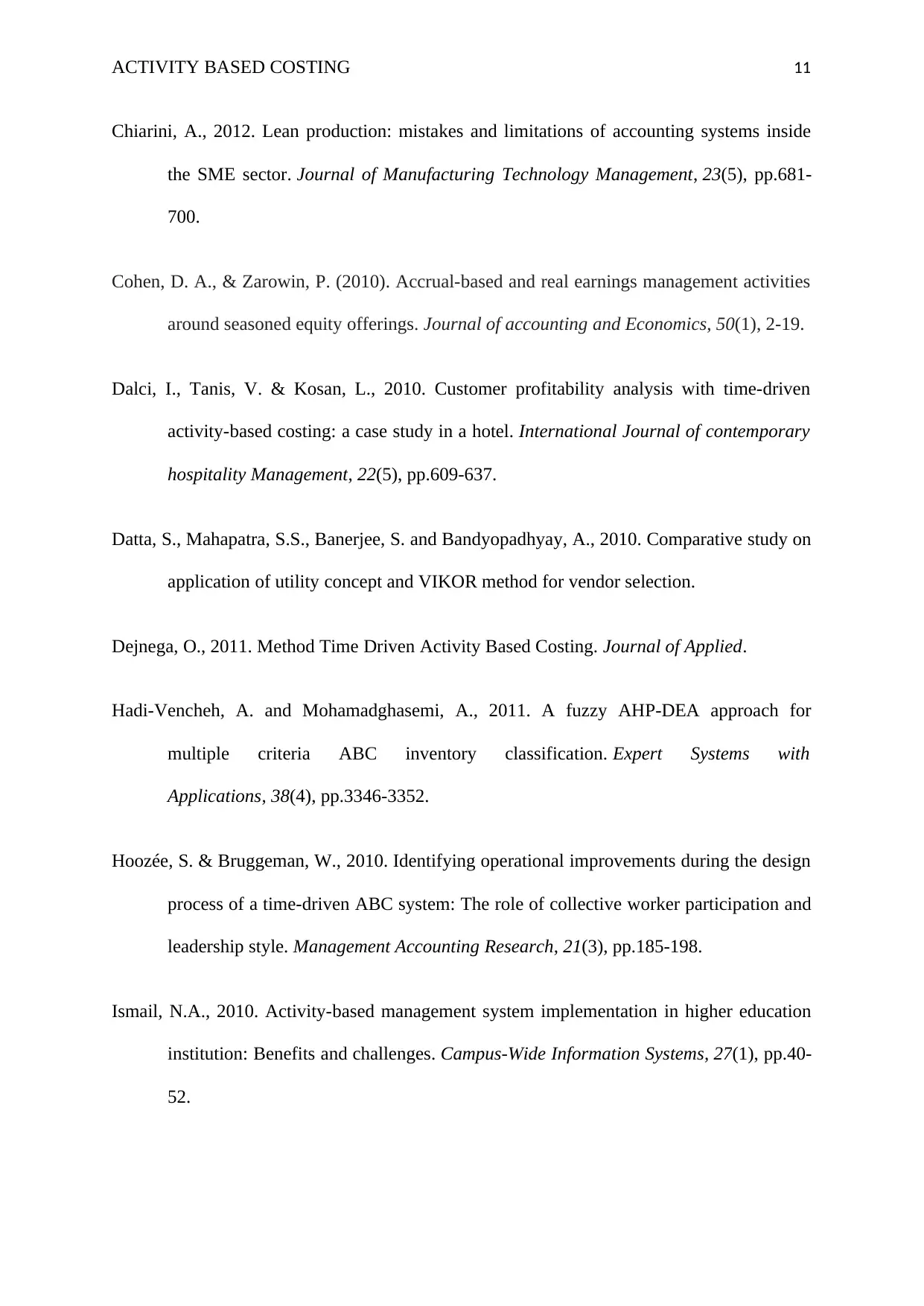
ACTIVITY BASED COSTING 11
Chiarini, A., 2012. Lean production: mistakes and limitations of accounting systems inside
the SME sector. Journal of Manufacturing Technology Management, 23(5), pp.681-
700.
Cohen, D. A., & Zarowin, P. (2010). Accrual-based and real earnings management activities
around seasoned equity offerings. Journal of accounting and Economics, 50(1), 2-19.
Dalci, I., Tanis, V. & Kosan, L., 2010. Customer profitability analysis with time-driven
activity-based costing: a case study in a hotel. International Journal of contemporary
hospitality Management, 22(5), pp.609-637.
Datta, S., Mahapatra, S.S., Banerjee, S. and Bandyopadhyay, A., 2010. Comparative study on
application of utility concept and VIKOR method for vendor selection.
Dejnega, O., 2011. Method Time Driven Activity Based Costing. Journal of Applied.
Hadi-Vencheh, A. and Mohamadghasemi, A., 2011. A fuzzy AHP-DEA approach for
multiple criteria ABC inventory classification. Expert Systems with
Applications, 38(4), pp.3346-3352.
Hoozée, S. & Bruggeman, W., 2010. Identifying operational improvements during the design
process of a time-driven ABC system: The role of collective worker participation and
leadership style. Management Accounting Research, 21(3), pp.185-198.
Ismail, N.A., 2010. Activity-based management system implementation in higher education
institution: Benefits and challenges. Campus-Wide Information Systems, 27(1), pp.40-
52.
Chiarini, A., 2012. Lean production: mistakes and limitations of accounting systems inside
the SME sector. Journal of Manufacturing Technology Management, 23(5), pp.681-
700.
Cohen, D. A., & Zarowin, P. (2010). Accrual-based and real earnings management activities
around seasoned equity offerings. Journal of accounting and Economics, 50(1), 2-19.
Dalci, I., Tanis, V. & Kosan, L., 2010. Customer profitability analysis with time-driven
activity-based costing: a case study in a hotel. International Journal of contemporary
hospitality Management, 22(5), pp.609-637.
Datta, S., Mahapatra, S.S., Banerjee, S. and Bandyopadhyay, A., 2010. Comparative study on
application of utility concept and VIKOR method for vendor selection.
Dejnega, O., 2011. Method Time Driven Activity Based Costing. Journal of Applied.
Hadi-Vencheh, A. and Mohamadghasemi, A., 2011. A fuzzy AHP-DEA approach for
multiple criteria ABC inventory classification. Expert Systems with
Applications, 38(4), pp.3346-3352.
Hoozée, S. & Bruggeman, W., 2010. Identifying operational improvements during the design
process of a time-driven ABC system: The role of collective worker participation and
leadership style. Management Accounting Research, 21(3), pp.185-198.
Ismail, N.A., 2010. Activity-based management system implementation in higher education
institution: Benefits and challenges. Campus-Wide Information Systems, 27(1), pp.40-
52.
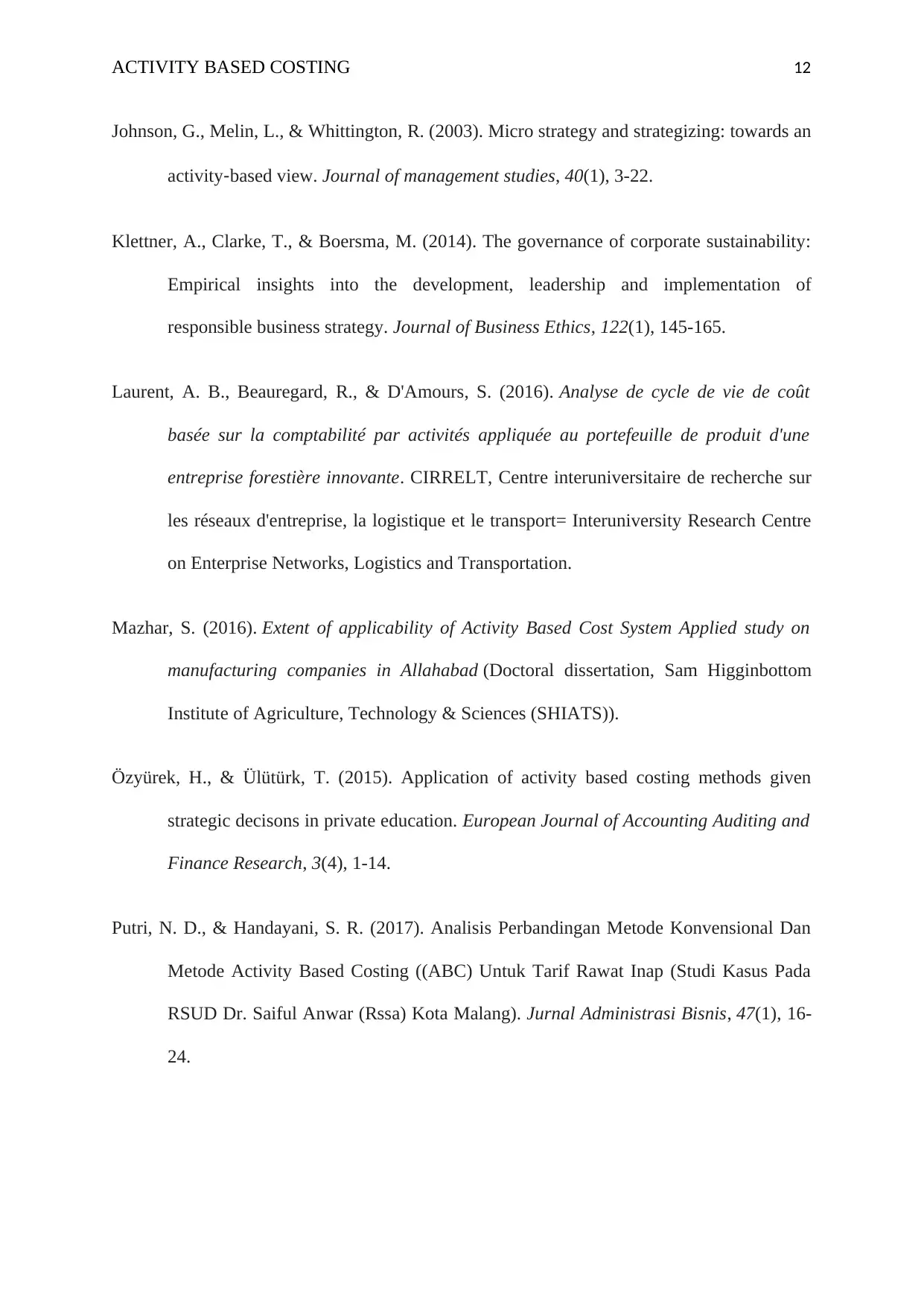
ACTIVITY BASED COSTING 12
Johnson, G., Melin, L., & Whittington, R. (2003). Micro strategy and strategizing: towards an
activity‐based view. Journal of management studies, 40(1), 3-22.
Klettner, A., Clarke, T., & Boersma, M. (2014). The governance of corporate sustainability:
Empirical insights into the development, leadership and implementation of
responsible business strategy. Journal of Business Ethics, 122(1), 145-165.
Laurent, A. B., Beauregard, R., & D'Amours, S. (2016). Analyse de cycle de vie de coût
basée sur la comptabilité par activités appliquée au portefeuille de produit d'une
entreprise forestière innovante. CIRRELT, Centre interuniversitaire de recherche sur
les réseaux d'entreprise, la logistique et le transport= Interuniversity Research Centre
on Enterprise Networks, Logistics and Transportation.
Mazhar, S. (2016). Extent of applicability of Activity Based Cost System Applied study on
manufacturing companies in Allahabad (Doctoral dissertation, Sam Higginbottom
Institute of Agriculture, Technology & Sciences (SHIATS)).
Özyürek, H., & Ülütürk, T. (2015). Application of activity based costing methods given
strategic decisons in private education. European Journal of Accounting Auditing and
Finance Research, 3(4), 1-14.
Putri, N. D., & Handayani, S. R. (2017). Analisis Perbandingan Metode Konvensional Dan
Metode Activity Based Costing ((ABC) Untuk Tarif Rawat Inap (Studi Kasus Pada
RSUD Dr. Saiful Anwar (Rssa) Kota Malang). Jurnal Administrasi Bisnis, 47(1), 16-
24.
Johnson, G., Melin, L., & Whittington, R. (2003). Micro strategy and strategizing: towards an
activity‐based view. Journal of management studies, 40(1), 3-22.
Klettner, A., Clarke, T., & Boersma, M. (2014). The governance of corporate sustainability:
Empirical insights into the development, leadership and implementation of
responsible business strategy. Journal of Business Ethics, 122(1), 145-165.
Laurent, A. B., Beauregard, R., & D'Amours, S. (2016). Analyse de cycle de vie de coût
basée sur la comptabilité par activités appliquée au portefeuille de produit d'une
entreprise forestière innovante. CIRRELT, Centre interuniversitaire de recherche sur
les réseaux d'entreprise, la logistique et le transport= Interuniversity Research Centre
on Enterprise Networks, Logistics and Transportation.
Mazhar, S. (2016). Extent of applicability of Activity Based Cost System Applied study on
manufacturing companies in Allahabad (Doctoral dissertation, Sam Higginbottom
Institute of Agriculture, Technology & Sciences (SHIATS)).
Özyürek, H., & Ülütürk, T. (2015). Application of activity based costing methods given
strategic decisons in private education. European Journal of Accounting Auditing and
Finance Research, 3(4), 1-14.
Putri, N. D., & Handayani, S. R. (2017). Analisis Perbandingan Metode Konvensional Dan
Metode Activity Based Costing ((ABC) Untuk Tarif Rawat Inap (Studi Kasus Pada
RSUD Dr. Saiful Anwar (Rssa) Kota Malang). Jurnal Administrasi Bisnis, 47(1), 16-
24.
⊘ This is a preview!⊘
Do you want full access?
Subscribe today to unlock all pages.

Trusted by 1+ million students worldwide
1 out of 13
Related Documents
Your All-in-One AI-Powered Toolkit for Academic Success.
+13062052269
info@desklib.com
Available 24*7 on WhatsApp / Email
![[object Object]](/_next/static/media/star-bottom.7253800d.svg)
Unlock your academic potential
Copyright © 2020–2025 A2Z Services. All Rights Reserved. Developed and managed by ZUCOL.





